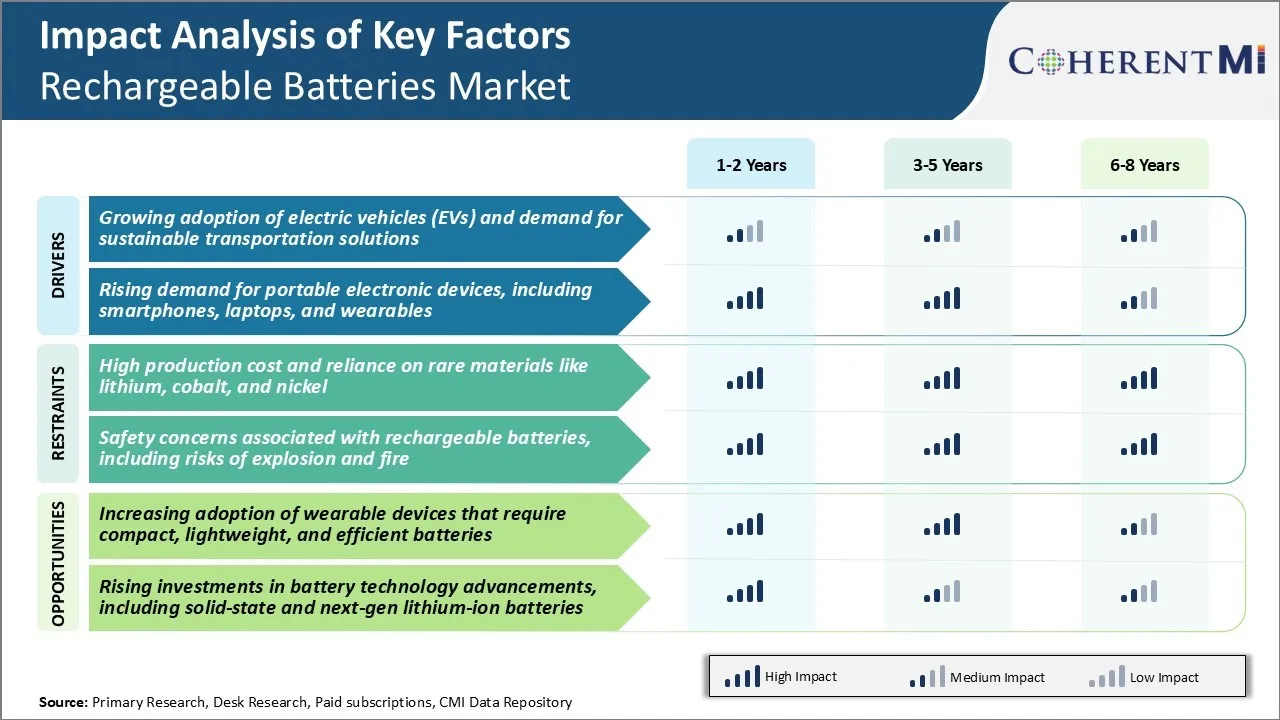Rechargeable Batteries Market Trends
Market Driver - Growing Adoption of Electric Vehicles (EVs) and Demand for Sustainable Transportation Solutions
The transportation sector is witnessing a growing trend towards more sustainable solutions with increasing concerns around climate change and environmental pollution. EVs have emerged as one of the most viable alternatives to fuel-based vehicles providing a cleaner mode of transportation. Governments in many countries are also providing significant incentives and subsidies to promote the mass adoption of EVs.
The declining battery costs and improving charging options are also making EVs more affordable and practical for everyday use. Various companies are introducing wireless and rapid charging stations to make it more convenient for EV owners. With traditional automakers as well as new entrants aggressively pushing EVs, the global EV fleet is expected to grow sharply in the coming years. This is likely to propel the demand for advanced rechargeable batteries that can meet the high energy density and power requirements of EVs.
Market Driver - Rising Demand for Portable Electronic Devices, including Smartphones, Laptops, and Wearables
Continual upgrades in features and functions as well as falling prices have led to phenomenal growth in the global sales of smartphones. Power-hungry high-resolution displays, multi-camera setups, processor upgrades, and 5G capabilities are driving the demand for high-density batteries. Rechargeable batteries that can support longer usage hours on a single charge are high in demand. Laptops and tablets are also advancing with processing power and connectivity capabilities, necessitating rechargeable batteries that deliver higher capacity and faster charging.
The growing popularity of wearable devices such as smartwatches, fitness trackers, smart glasses, and wireless earbuds have created new avenues for rechargeable batteries. However, the miniature form factors of wearables pose unique engineering challenges for batteries to deliver adequate runtime without compromising comfort or aesthetics. In order to power the myriad classes of portable devices effectively, manufacturers in the rechargeable batteries market are consistently innovating with new chemistries, designs, and charging solutions to meet evolving consumer demands. This augurs well for the future prospects of the rechargeable batteries market.

Market Challenge - High Production Cost and Reliance on Rare Materials
One of the key challenges faced by the rechargeable batteries market is the high production costs associated with these batteries. Producing rechargeable batteries at scale requires significant investments in manufacturing plants and equipment. This leads to high fixed costs for battery manufacturers.
The mining and processing of these materials is an expensive process. The prices of these raw materials also fluctuate frequently depending on global supply and demand forces. Any shortage or price spike of these critical materials can adversely impact production costs for battery makers. The reliance on rare materials also raises sustainability and geopolitical concerns. Many of these materials are sourced from unstable regions raising supply security risks.
The energy intensive mining and refining processes also have negative environmental impacts. Unless production costs come down significantly or battery designs transition to more sustainable and affordable materials, high costs will continue to restrain widespread mass adoption of rechargeable batteries.
Market Opportunity - Increasing Adoption of Wearable Devices
One of the major opportunities for the rechargeable batteries market is the increasing adoption of wearable devices that require compact, lightweight, and efficient batteries. The market for wearable devices such as smartwatches, fitness trackers, smart glasses, healthcare monitors and others is growing rapidly. All these devices need miniature power sources to function without hampering portability and form factor.
Rechargeable lithium ion batteries have become the technology of choice for wearable devices owing to their high energy density and long battery life. As more consumers adopt cutting-edge wearable devices, the demand for powerful yet small-sized rechargeable batteries will continue expanding.
Battery makers can capitalize on this opportunity by developing specialized battery chemistries, form factors, and charging solutions tailored for the unique power needs of the wearables industry. The wearables sector provides a major growth avenue for battery players as it acts as an ambassador for other portable consumer electronics that runs on battery power.